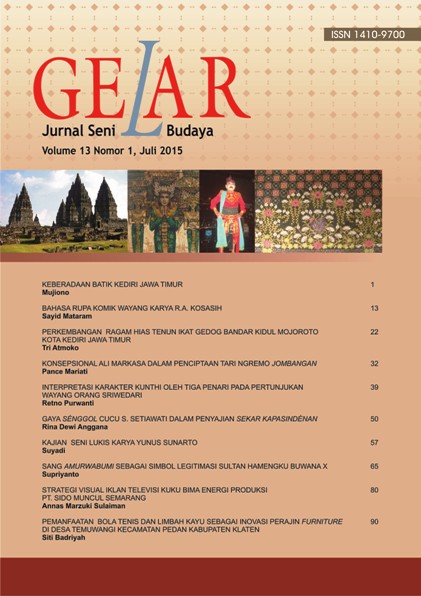SANG AMURWABUMI SEBAGAI SIMBOL LEGITIMASI SULTAN HAMENGKU BUWANA X
Main Article Content
Abstract
Beksan Bedhaya, refers to its understanding, belongs to traditional theater, a valuable form of art that is stillconserved in the palace including Surakarta as well as Yogyakarta Palace. Traditionally, dance Bedhaya isdanced in group by nine young female dancers. Dance Bedhaya, with its sacred, takes a story based on mythor legend that thematically contains of philosophic and sociolinguistic meanings as well as bringing ethic andmoral values, and also actual life teachings of a certain age. The spiritual aspects, hereditary, have becomea basic concept that bases the aesthetic choreographic concept of dance Bedhaya. All process of danceBedhaya and its dancers’ names related to the symbol from the beginning until the end represent the humanbirth, life, and death. The process tells about purwa (beginning/birth), madya (life), and wasana (the end) ofhuman life. The understanding of content and meaning in dance Bedhaya Amurwabumi contains ritual valuesas the forms of glory and legitimacy along with other things. Dance Bedhaya also has a function to keep theunity between Sultan and his kawula (people) that is found in the concept of manunggaling kawula alit orcuriga manjing warangka, warangka manjing curiga.
Keywords: Bedhaya, Sang Amujrwabumi
Downloads
Article Details
Copyright
Authors who publish with Gelar: Jurnal Seni Budaya agrees to the following terms:
- Authors retain copyright and grant the journal right of first publication with the work simultaneously licensed under a Creative Commons Attribution License (CC BY-SA 4.0) that allows others to share the work with an acknowledgment of the work's authorship and initial publication in this journal.
- Authors are able to enter into separate, additional contractual arrangements for the non-exclusive distribution of the journal's published version of the work (e.g., post it to an institutional repository or publish it in a book), with an acknowledgment of its initial publication in this journal.
- Authors are permitted and encouraged to post their work online (e.g., in institutional repositories or on their website) prior to and during the submission process, as it can lead to productive exchanges, as well as earlier and greater citation of published work.
